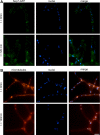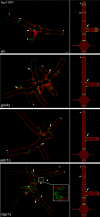Regulation of distinct septin rings in a single cell by Elm1p and Gin4p kinases
- PMID: 19225152
- PMCID: PMC2669037
- DOI: 10.1091/mbc.e08-12-1169
Regulation of distinct septin rings in a single cell by Elm1p and Gin4p kinases
Abstract
Septins are conserved, GTP-binding proteins that assemble into higher order structures, including filaments and rings with varied cellular functions. Using four-dimensional quantitative fluorescence microscopy of Ashbya gossypii fungal cells, we show that septins can assemble into morphologically distinct classes of rings that vary in dimensions, intensities, and positions within a single cell. Notably, these different classes coexist and persist for extended times, similar in appearance and behavior to septins in mammalian neurons and cultured cells. We demonstrate that new septin proteins can add through time to assembled rings, indicating that septins may continue to polymerize during ring maturation. Different classes of rings do not arise from the presence or absence of specific septin subunits and ring maintenance does not require the actin and microtubule cytoskeletons. Instead, morphological and behavioral differences in the rings require the Elm1p and Gin4p kinases. This work demonstrates that distinct higher order septin structures form within one cell because of the action of specific kinases.
Figures









Similar articles
-
Septin phosphorylation and coiled-coil domains function in cell and septin ring morphology in the filamentous fungus Ashbya gossypii.Eukaryot Cell. 2013 Feb;12(2):182-93. doi: 10.1128/EC.00251-12. Epub 2012 Nov 30. Eukaryot Cell. 2013. PMID: 23204191 Free PMC article.
-
Cellular requirements for the small molecule forchlorfenuron to stabilize the septin cytoskeleton.Cytoskeleton (Hoboken). 2010 Jun;67(6):383-99. doi: 10.1002/cm.20452. Cytoskeleton (Hoboken). 2010. PMID: 20517926
-
An anillin homologue, Mid2p, acts during fission yeast cytokinesis to organize the septin ring and promote cell separation.J Cell Biol. 2003 Mar 31;160(7):1093-103. doi: 10.1083/jcb.200211126. J Cell Biol. 2003. PMID: 12668659 Free PMC article.
-
Spatial effects - site-specific regulation of actin and microtubule organization by septin GTPases.J Cell Sci. 2018 Jan 11;131(1):jcs207555. doi: 10.1242/jcs.207555. J Cell Sci. 2018. PMID: 29326311 Free PMC article. Review.
-
The Mammalian Septin Interactome.Front Cell Dev Biol. 2017 Feb 7;5:3. doi: 10.3389/fcell.2017.00003. eCollection 2017. Front Cell Dev Biol. 2017. PMID: 28224124 Free PMC article. Review.
Cited by
-
Dephosphorylation of the Core Septin, AspB, in a Protein Phosphatase 2A-Dependent Manner Impacts Its Localization and Function in the Fungal Pathogen Aspergillus fumigatus.Front Microbiol. 2016 Jun 22;7:997. doi: 10.3389/fmicb.2016.00997. eCollection 2016. Front Microbiol. 2016. PMID: 27446037 Free PMC article.
-
Sporulation in Ashbya gossypii.J Fungi (Basel). 2020 Aug 29;6(3):157. doi: 10.3390/jof6030157. J Fungi (Basel). 2020. PMID: 32872517 Free PMC article. Review.
-
An amphipathic helix enables septins to sense micrometer-scale membrane curvature.J Cell Biol. 2019 Apr 1;218(4):1128-1137. doi: 10.1083/jcb.201807211. Epub 2019 Jan 18. J Cell Biol. 2019. PMID: 30659102 Free PMC article.
-
Interplay of septin amphipathic helices in sensing membrane-curvature and filament bundling.Mol Biol Cell. 2021 Oct 1;32(20):br5. doi: 10.1091/mbc.E20-05-0303. Epub 2021 Jul 28. Mol Biol Cell. 2021. PMID: 34319771 Free PMC article.
-
The Nim1 kinase Gin4 has distinct domains crucial for septin assembly, phospholipid binding and mitotic exit.J Cell Sci. 2016 Jul 15;129(14):2744-56. doi: 10.1242/jcs.183160. Epub 2016 May 26. J Cell Sci. 2016. PMID: 27231094 Free PMC article.
References
-
- Alberti-Segui C., Dietrich F., Altmann-Johl R., Hoepfner D., Philippsen P. Cytoplasmic dynein is required to oppose the force that moves nuclei towards the hyphal tip in the filamentous ascomycete Ashbya gossypii. J. Cell Sci. 2001;114:975–986. - PubMed
-
- Ayad-Durieux Y., Knechtle P., Goff S., Dietrich F., Philippsen P. A PAK-like protein kinase is required for maturation of young hyphae and septation in the filamentous ascomycete Ashbya gossypii. J. Cell Sci. 2000;113:4563–4575. - PubMed
-
- Barral Y., Mermall V., Mooseker M. S., Snyder M. Compartmentalization of the cell cortex by septins is required for maintenance of cell polarity in yeast. Mol. Cell. 2000;5:841–851. - PubMed
-
- Bertin A., McMurray M. A., Grob P., Park S. S., Garcia G., 3rd, Patanwala I., Ng H. L., Alber T., Thorner J., Nogales E. Saccharomyces cerevisiae septins: supramolecular organization of heterooligomers and the mechanism of filament assembly. Proc. Natl. Acad. Sci. USA. 2008;105:8274–8279. - PMC - PubMed
Publication types
MeSH terms
Substances
LinkOut - more resources
Full Text Sources

